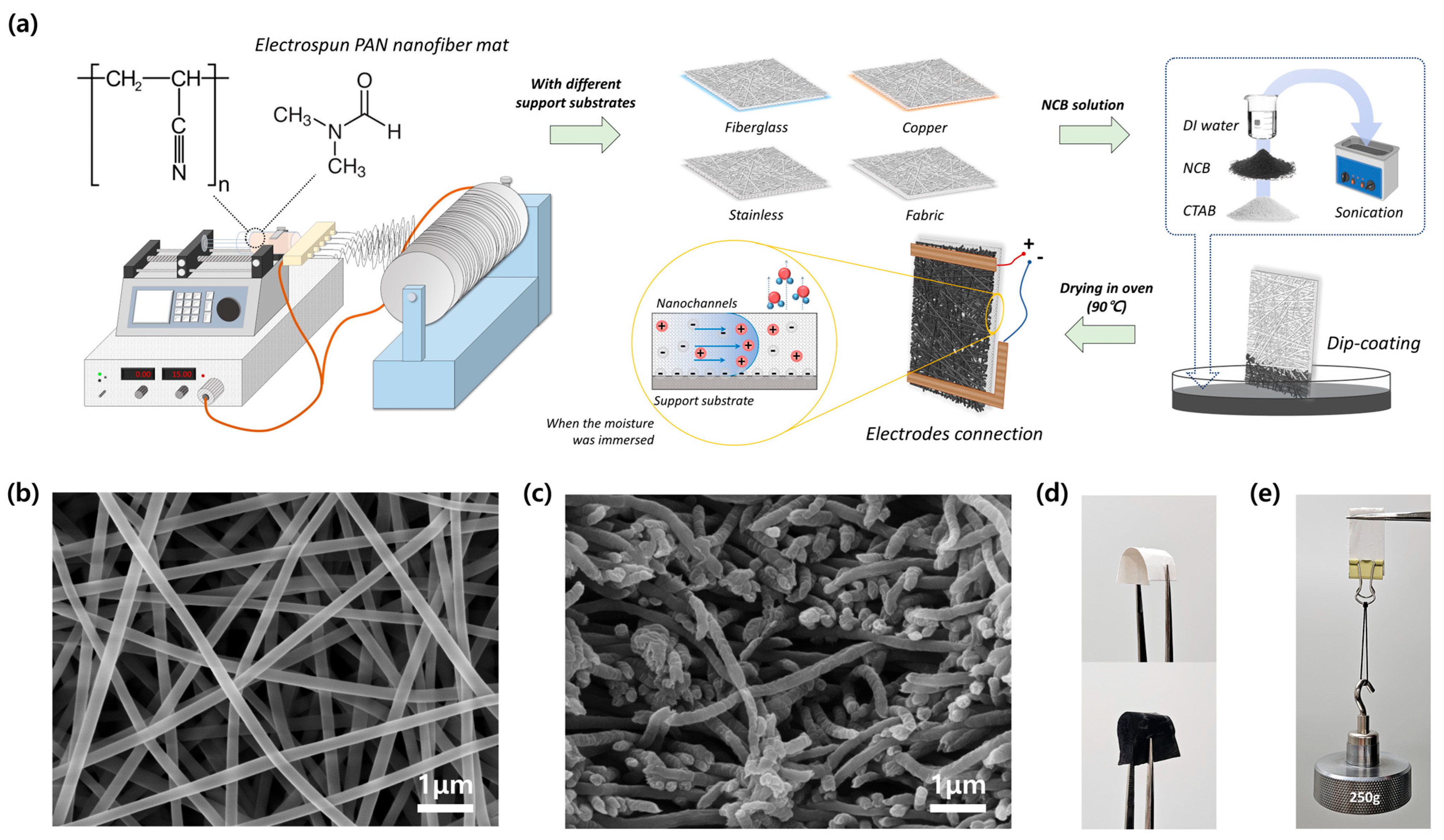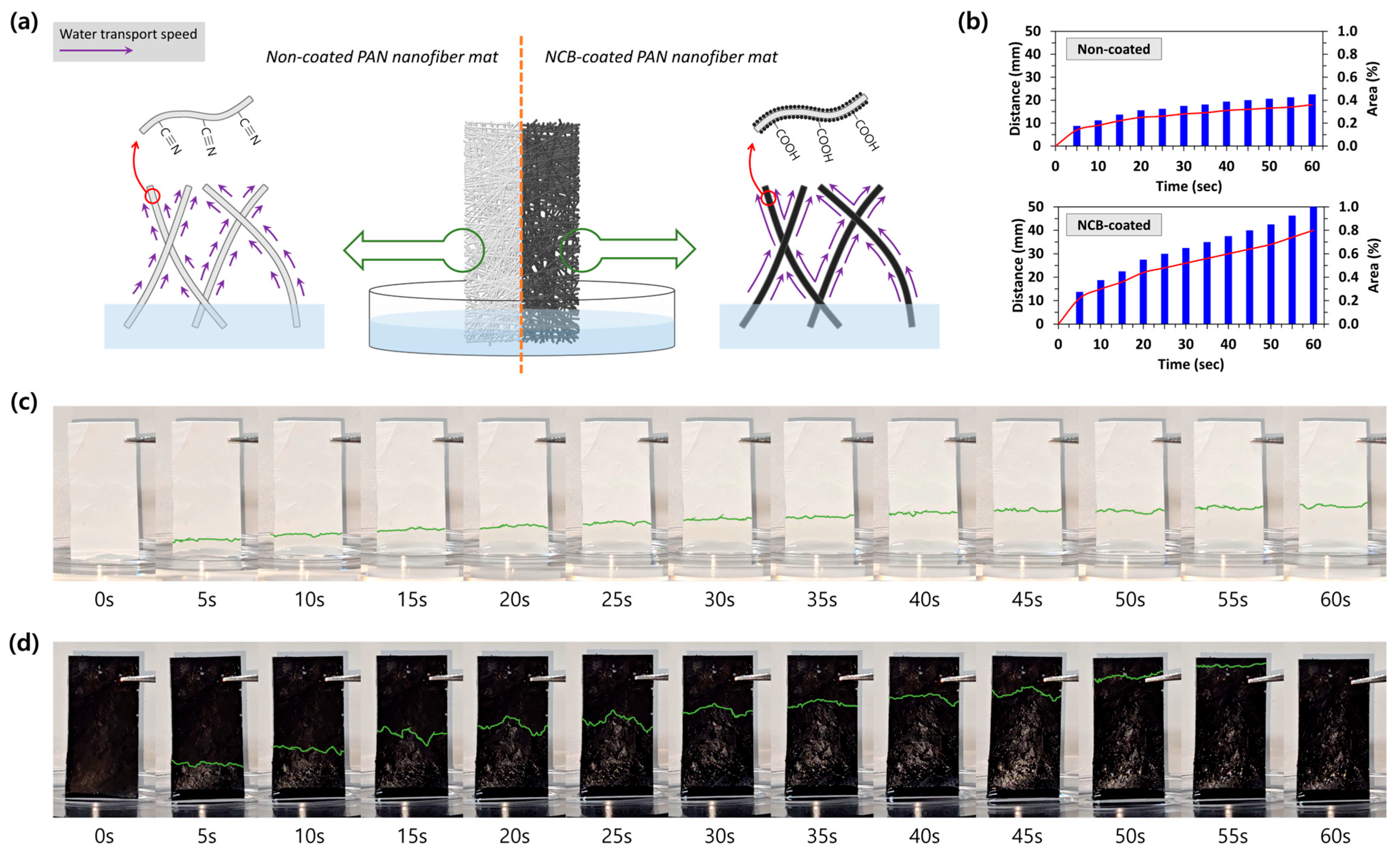Evaporation-Driven Energy Generation Using an Electrospun Polyacrylonitrile Nanofiber Mat with Different Support Substrates
Abstract
:1. Introduction
2. Materials and Methods
2.1. Materials
2.2. Fabrication of PAN Nanofiber Mat
2.3. Characterization of Evaporation-Driven Electricity Generator
3. Results and Discussion
3.1. Preparation and Characterization of PAN Nanofiber Mat
3.2. Characterization of PEEGs
3.3. Evaluation of Electrical Performances by Different Support Substrates
4. Conclusions
Author Contributions
Funding
Institutional Review Board Statement
Data Availability Statement
Conflicts of Interest
References
- Akella, A.; Saini, R.; Sharma, M.P. Social, economical and environmental impacts of renewable energy systems. Renew. Energy 2009, 34, 390–396. [Google Scholar] [CrossRef]
- Yao, Y.; Chang, Y.; Masanet, E. A hybrid life-cycle inventory for multi-crystalline silicon PV module manufacturing in China. Environ. Res. Lett. 2014, 9, 114001. [Google Scholar] [CrossRef]
- Uddin, M.S.; Kumar, S. Energy, emissions and environmental impact analysis of wind turbine using life cycle assessment technique. J. Clean. Prod. 2014, 69, 153–164. [Google Scholar] [CrossRef]
- Saidur, R.; Rahim, N.A.; Islam, M.R.; Solangi, K.H. Environmental impact of wind energy. Renew. Sustain. Energy. Rev. 2011, 15, 2423–2430. [Google Scholar] [CrossRef]
- Nazir, M.S.; Ali, N.; Bilal, M.; Iqbal, H.M. Potential environmental impacts of wind energy development: A global perspective. Curr. Opin. Environ. Sci. Health 2020, 13, 85–90. [Google Scholar] [CrossRef]
- Chen, S.; Chen, B.; Fath, B.D. Assessing the cumulative environmental impact of hydropower construction on river systems based on energy network model. Renew. Sustain. Energy. Rev. 2015, 42, 78–92. [Google Scholar] [CrossRef]
- Tsoutsos, T.; Frantzeskaki, N.; Gekas, V. Environmental impacts from the solar energy technologies. Energy Policy 2005, 33, 289–296. [Google Scholar] [CrossRef]
- Liu, P.; Barlow, C.Y. Wind turbine blade waste in 2050. Waste Manag. 2017, 62, 229–240. [Google Scholar] [CrossRef] [PubMed]
- Liang, X.; Jiang, T.; Feng, Y.; Lu, P.; An, J.; Wang, Z.L. Triboelectric nanogenerator network integrated with charge excitation circuit for effective water wave energy harvesting. Adv. Energy Mater. 2020, 10, 2002123. [Google Scholar] [CrossRef]
- Fei, W.; Shen, C.; Zhang, S.; Chen, H.; Li, L.; Guo, W. Waving potential at volt level by a pair of graphene sheets. Nano Energy 2019, 60, 656–660. [Google Scholar] [CrossRef]
- Xu, W.; Zheng, H.; Liu, Y.; Zhou, X.; Zhang, C.; Song, Y.; Deng, X.; Leung, M.; Yang, Z.; Xu, R.X. A droplet-based electricity generator with high instantaneous power density. Nature 2020, 578, 392–396. [Google Scholar] [CrossRef]
- Gao, D.; Liu, C.; Fan, S. A new type of flexible energy harvesting device working with micro water droplets achieving high output. J. Mater. Chem. A 2021, 9, 23555–23562. [Google Scholar] [CrossRef]
- Bae, J.; Yun, T.G.; Suh, B.L.; Kim, J.; Kim, I.-D. Self-operating transpiration-driven electrokinetic power generator with an artificial hydrological cycle. Energy. Environ. Sci. 2020, 13, 527–534. [Google Scholar] [CrossRef]
- Li, L.; Gao, S.; Hao, M.; Yang, X.; Feng, S.; Li, L.; Wang, S.; Xiong, Z.; Sun, F.; Li, Y. A novel, flexible dual-mode power generator adapted for wide dynamic range of the aqueous salinity. Nano Energy 2021, 85, 105970. [Google Scholar] [CrossRef]
- Shin, S.-H.; Cheong, J.Y.; Lim, H.; Padil, V.V.; Venkateshaiah, A.; Kim, I.-D. Carbon anchored conducting polymer composite linkage for high performance water energy harvesters. Nano Energy 2020, 74, 104827. [Google Scholar] [CrossRef]
- Lee, S.-H.; Lee, H.-W.; Baek, S.H.; Yun, J.; Kwon, Y.; Song, Y.; Kim, B.S.; Choa, Y.-H.; Jeong, D.-W. Water-Based Generators with Cellulose Acetate: Uncovering the Mechanisms of Power Generation. Polymers 2024, 16, 433. [Google Scholar] [CrossRef] [PubMed]
- Tao, Y.; Wang, Z.; Xu, H.; Ding, W.; Zhao, X.; Lin, Y.; Liu, Y. Moisture-powered memristor with interfacial oxygen migration for power-free reading of multiple memory states. Nano Energy 2020, 71, 104628. [Google Scholar] [CrossRef]
- Liu, X.; Gao, H.; Ward, J.E.; Liu, X.; Yin, B.; Fu, T.; Chen, J.; Lovley, D.R.; Yao, J. Power generation from ambient humidity using protein nanowires. Nature 2020, 578, 550–554. [Google Scholar] [CrossRef] [PubMed]
- Wu, C.; Wang, A.C.; Ding, W.; Guo, H.; Wang, Z.L. Triboelectric nanogenerator: A foundation of the energy for the new era. Adv. Energy Mater. 2019, 9, 1802906. [Google Scholar] [CrossRef]
- Lu, L.; Ding, W.; Liu, J.; Yang, B. Flexible PVDF based piezoelectric nanogenerators. Nano Energy 2020, 78, 105251. [Google Scholar] [CrossRef]
- Deng, W.; Zhou, Y.; Libanori, A.; Chen, G.; Yang, W.; Chen, J. Piezoelectric nanogenerators for personalized healthcare. Chem. Soc. Rev. 2022, 51, 3380–3435. [Google Scholar] [CrossRef] [PubMed]
- Kim, W.-G.; Kim, D.-W.; Tcho, I.-W.; Kim, J.-K.; Kim, M.-S.; Choi, Y.-K. Triboelectric nanogenerator: Structure, mechanism, and applications. ACS Nano 2021, 15, 258–287. [Google Scholar] [CrossRef]
- Jiao, S.; Liu, M.; Li, Y.; Abrha, H.; Wang, J.; Dai, Y.; Li, J.; Kang, N.; Li, Y.; Liu, X. Emerging hydrovoltaic technology based on carbon black and porous carbon materials: A mini review. Carbon 2022, 193, 339–355. [Google Scholar] [CrossRef]
- Zheng, C.; Chu, W.; Fang, S.; Tan, J.; Wang, X.; Guo, W. Materials for evaporation-driven hydrovoltaic technology. Interdiscip. Mater. 2022, 1, 449–470. [Google Scholar] [CrossRef]
- Zhao, Q.; Jiang, Y.; Duan, Z.; Yuan, Z.; Zha, J.; Wu, Z.; Huang, Q.; Zhou, Z.; Li, H.; He, F. A Nb2CTx/sodium alginate-based composite film with neuron-like network for self-powered humidity sensing. Chem. Eng. J. 2022, 438, 135588. [Google Scholar] [CrossRef]
- Bae, J.; Kim, M.S.; Oh, T.; Suh, B.L.; Yun, T.G.; Lee, S.; Hur, K.; Gogotsi, Y.; Koo, C.M.; Kim, I.-D. Towards Watt-scale hydroelectric energy harvesting by Ti3C2Tx-based transpiration-driven electrokinetic power generators. Energy Environ. Sci. 2022, 15, 123–135. [Google Scholar] [CrossRef]
- Lv, Y.; Gong, F.; Li, H.; Zhou, Q.; Wu, X.; Wang, W.; Xiao, R. A flexible electrokinetic power generator derived from paper and ink for wearable electronics. Appl. Energy. 2020, 279, 115764. [Google Scholar] [CrossRef]
- Kaur, M.; Nagao, T. Minireview on solar desalination and hydropower generation by water evaporation: Recent challenges and perspectives in materials science. Energy Fuels 2022, 36, 11443–11456. [Google Scholar] [CrossRef]
- Zhang, K.; Cai, L.; Nilghaz, A.; Chen, G.; Wan, X.; Tian, J. Enhancing output performance of surface-modified wood sponge-carbon black ink hygroelectric generator via moisture-triggered galvanic cell. Nano Energy 2022, 98, 107288. [Google Scholar] [CrossRef]
- Wu, M.; Peng, M.; Liang, Z.; Liu, Y.; Zhao, B.; Li, D.; Wang, Y.; Zhang, J.; Sun, Y.; Jiang, L. Printed honeycomb-structured reduced graphene oxide film for efficient and continuous evaporation-driven electricity generation from salt solution. ACS Appl. Mater. Interfaces 2021, 13, 26989–26997. [Google Scholar] [CrossRef]
- Sun, Z.; Feng, L.; Wen, X.; Wang, L.; Qin, X.; Yu, J. Ceramic nanofiber-based water-induced electric generator. ACS Appl. Mater. Interfaces 2021, 13, 56226–56232. [Google Scholar] [CrossRef]
- Xue, J.; Zhao, F.; Hu, C.; Zhao, Y.; Luo, H.; Dai, L.; Qu, L. Vapor-activated power generation on conductive polymer. Adv. Funct. Mater. 2016, 26, 8784–8792. [Google Scholar] [CrossRef]
- Fang, S.; Chu, W.; Tan, J.; Guo, W. The mechanism for solar irradiation enhanced evaporation and electricity generation. Nano Energy 2022, 101, 107605. [Google Scholar] [CrossRef]
- Dao, V.-D.; Vu, N.H.; Dang, T.H.-L.; Yun, S. Recent advances and challenges for water evaporation-induced electricity toward applications. Nano Energy 2021, 85, 105979. [Google Scholar] [CrossRef]
- Tabrizizadeh, T.; She, Z.; Stamplecoskie, K.; Liu, G. Empowerment of water-evaporation-induced electric generators via the use of metal electrodes. ACS Omega 2022, 7, 28275–28283. [Google Scholar] [CrossRef] [PubMed]
- Chi, J.; Liu, C.; Che, L.; Li, D.; Fan, K.; Li, Q.; Yang, W.; Dong, L.; Wang, G.; Wang, Z.L. Harvesting Water-Evaporation-Induced Electricity Based on Liquid–Solid Triboelectric Nanogenerator. Adv. Sci. 2022, 9, 2201586. [Google Scholar] [CrossRef]
- Tabrizizadeh, T.; Wang, J.; Kumar, R.; Chaurasia, S.; Stamplecoskie, K.; Liu, G. Water-evaporation-induced electric generator built from carbonized electrospun polyacrylonitrile nanofiber mats. ACS Appl. Mater. Interfaces 2021, 13, 50900–50910. [Google Scholar] [CrossRef]
- Yun, T.G.; Bae, J.; Rothschild, A.; Kim, I.-D. Transpiration driven electrokinetic power generator. ACS Nano 2019, 13, 12703–12709. [Google Scholar] [CrossRef] [PubMed]
- Wu, M.; Liang, Z.; Peng, M.; Zhao, B.; Li, D.; Zhang, J.; Sun, Y.; Jiang, L. High evaporation rate and electrical conductivity synergistically boosting porous rGO/CNT Film for water evaporation-driven electricity generation. Nano Energy 2023, 116, 108771. [Google Scholar] [CrossRef]
- Park, J.H.; Park, S.H.; Lee, J.; Lee, S.J. Solar evaporation-based energy harvesting using a leaf-inspired energy-harvesting foam. ACS Sustain. Chem. Eng. 2021, 9, 5027–5037. [Google Scholar] [CrossRef]
- Zhou, X.; Zhang, W.; Zhang, C.; Tan, Y.; Guo, J.; Sun, Z.; Deng, X. Harvesting electricity from water evaporation through microchannels of natural wood. ACS Appl. Mater. Interfaces 2020, 12, 11232–11239. [Google Scholar] [CrossRef] [PubMed]
- Venkateshaiah, A.; Cheong, J.Y.; Shin, S.-H.; Akshaykumar, K.; Yun, T.G.; Bae, J.; Wacławek, S.; Černík, M.; Agarwal, S.; Greiner, A. Recycling non-food-grade tree gum wastes into nanoporous carbon for sustainable energy harvesting. Green. Chem. 2020, 22, 1198–1208. [Google Scholar] [CrossRef]
- Jin, H.; Yoon, S.G.; Lee, W.H.; Cho, Y.H.; Han, J.; Park, J.; Kim, Y.S. Identification of water-infiltration-induced electrical energy generation by ionovoltaic effect in porous CuO nanowire films. Energy Environ. Sci. 2020, 13, 3432–3438. [Google Scholar] [CrossRef]
- Shao, C.; Ji, B.; Xu, T.; Gao, J.; Gao, X.; Xiao, Y.; Zhao, Y.; Chen, N.; Jiang, L.; Qu, L. Large-scale production of flexible, high-voltage hydroelectric films based on solid oxides. ACS Appl. Mater. Interfaces 2019, 11, 30927–30935. [Google Scholar] [CrossRef] [PubMed]




| Materials | Device Size | Generation Outputs | Years | Ref | |
|---|---|---|---|---|---|
| Voc | Isc | ||||
| Carbon nanotube film | 0.5 × 1.0 cm2 | 0.98 V | 515.6 μA | 2023 | [39] |
| Ceramic (SiO2) nanofiber | 2.0 × 6.0 cm2 | 0.48 V | 0.37 μA | 2021 | [31] |
| Polymer foam | 15.0 × 15.0 × 10.0 mm3 | 0.25 V | 42.0 μA | 2021 | [40] |
| Natural wood | 5.0 × 5.0 × 1.0 cm3 | 0.3 V | 10.0 μA | 2020 | [41] |
| Lower-grade gums | 1.0 × 2.5 cm2 | 0.4 V | 3.0 μA | 2020 | [42] |
| CuO nanowire films | 1.5 × 6.0 cm2 | 0.45 V | 0.23 μA | 2020 | [43] |
| Flexible hydroelectric films | 16.0 × 4.0 cm2 | 2.5 V | 0.8 μA | 2019 | [44] |
| Cotton fabric | 30 × 90 × 0.12 mm3 | 0.74 V | 22.5 μA | 2019 | [13] |
Disclaimer/Publisher’s Note: The statements, opinions and data contained in all publications are solely those of the individual author(s) and contributor(s) and not of MDPI and/or the editor(s). MDPI and/or the editor(s) disclaim responsibility for any injury to people or property resulting from any ideas, methods, instructions or products referred to in the content. |
© 2024 by the authors. Licensee MDPI, Basel, Switzerland. This article is an open access article distributed under the terms and conditions of the Creative Commons Attribution (CC BY) license (https://creativecommons.org/licenses/by/4.0/).
Share and Cite
Kwon, Y.; Bui-Vinh, D.; Lee, S.-H.; Baek, S.H.; Lee, S.; Yun, J.; Baek, M.; Lee, H.-W.; Park, J.; Kim, M.; et al. Evaporation-Driven Energy Generation Using an Electrospun Polyacrylonitrile Nanofiber Mat with Different Support Substrates. Polymers 2024, 16, 1180. https://doi.org/10.3390/polym16091180
Kwon Y, Bui-Vinh D, Lee S-H, Baek SH, Lee S, Yun J, Baek M, Lee H-W, Park J, Kim M, et al. Evaporation-Driven Energy Generation Using an Electrospun Polyacrylonitrile Nanofiber Mat with Different Support Substrates. Polymers. 2024; 16(9):1180. https://doi.org/10.3390/polym16091180
Chicago/Turabian StyleKwon, Yongbum, Dai Bui-Vinh, Seung-Hwan Lee, So Hyun Baek, Songhui Lee, Jeungjai Yun, Minwoo Baek, Hyun-Woo Lee, Jaebeom Park, Miri Kim, and et al. 2024. "Evaporation-Driven Energy Generation Using an Electrospun Polyacrylonitrile Nanofiber Mat with Different Support Substrates" Polymers 16, no. 9: 1180. https://doi.org/10.3390/polym16091180






